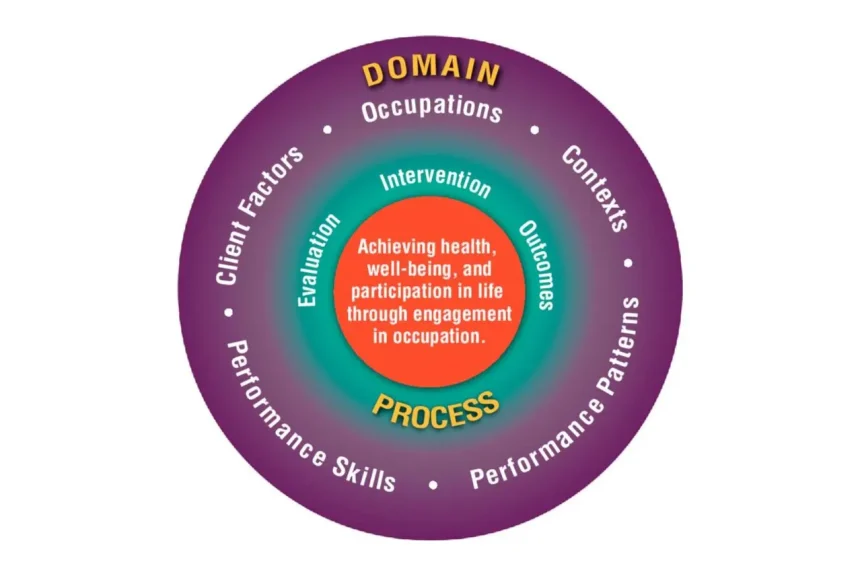The OTPF–4 is an official document of the American Occupational Therapy Association (AOTA®), intended as a fundamental resource for occupational therapy practitioners and students. This framework outlines the core domains and processes of occupational therapy (OT) practice, supporting students preparing for the NBCOT® exam with a structured approach to understanding OT’s scope and methodology.
OTPF-4: Breaking Down the Domain and Process
The OTPF-4 consists of two interrelated components: Domain and Process. These components guide OT practitioners in delivering effective and client-centered services.
Understanding the OTPF Domain
The Domain defines the areas in which occupational therapy practitioners have established knowledge and skills. It includes:
- Occupations: Activities central to a client’s life such as ADLs, work, and leisure.
- Contexts: Environmental and personal factors emphasizing the importance of individual, situational influences.
- Performance Patterns: The habits, routines, roles, and rituals influencing engagement in occupations.
- Performance Skills: Observable goal-directed actions used during task performance, encompassing motor, process, and social interaction skills.
- Client Factors: Underlying values, body functions, and structures impacting occupational performance.
Exploring OTPF Performance Skills
Performance skills are crucial as they reveal how clients interact with and perform tasks in real-world settings. Understanding these skills helps practitioners identify strengths and challenges in participation.
Example: During therapy, a student may practice social interactions to improve task engagement during group projects.
The Process: Evaluation, Intervention, and Outcomes
The Process part describes the practitioner’s actions in providing services. This client-centered approach involves:
- Evaluation: Understanding client needs and contexts through occupational profiles and performance analysis.
- Intervention: Utilization of targeted strategies to enhance engagement, such as occupation-based practices.
- Outcomes: Measuring success through improved performance and participation in desired occupations.
Actionable Tips for OTPF Studies
- Practice task-oriented group activities weekly to enhance understanding of performance skills.
- Create scenarios to explore different contexts affecting occupational performance.
- Undertake case studies to identify and differentiate performance patterns and client factors.
Understanding Providing OTPF Domains
The OTPF segments into specific domain areas such as performances, contexts, and client factors paramount for engaging in occupations. Questions like “Can you identify how context impacts performance?” can initiate a deeper understanding among students.
Our full guide at passtheot.com delves deeper into each component with practical scenarios and quizzes to test your knowledge and readiness for the NBCOT® exam.
Want detailed practice tips to ace the NBCOT® exam? Join now for full access!
What is the purpose of the OTPF-4 in occupational therapy?
The OTPF-4 serves as an official document by the American Occupational Therapy Association that outlines the core domains and processes of occupational therapy practice. It acts as a fundamental resource for OT practitioners and students, helping them understand the scope and methodology of occupational therapy.
What are the key components of the OTPF-4 framework?
The OTPF-4 framework consists of two main components: Domain and Process. The Domain covers areas where OT practitioners apply their knowledge and skills, such as occupations, contexts, performance patterns, performance skills, and client factors. The Process focuses on the evaluation, intervention, and outcomes stages of OT service delivery.
How does the OTPF-4 define 'Domain' in occupational therapy?
The Domain in OTPF-4 encompasses areas of established OT knowledge and skills, including occupations, contexts, performance patterns, performance skills, and client factors. These domains guide practitioners in delivering client-centered occupational therapy services.
Can you explain the 'Process' component in OTPF-4?
The Process component of the OTPF-4 involves the steps practitioners take to provide OT services, which include evaluation, intervention, and measuring outcomes. This client-centered approach helps tailor therapy to each client’s unique needs and goals.
What strategies can help OT students prepare for the NBCOT® exam?
OT students can enhance their preparation for the NBCOT® exam by practicing task-oriented group activities to understand performance skills, creating scenarios to explore contexts affecting performance, and undertaking case studies to distinguish performance patterns and client factors. Our full guide at passtheot.com offers deeper insights, practical scenarios, and quizzes.



